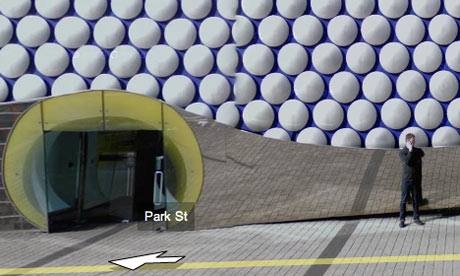- Internet giant’s busiest day as traffic jumps 41%
- Invasive pictures are removed from site

Google street views, Birmingham. Photograph: Google
For 24 hours, Google’s new Street View brought a vision of British cities to the web that included such memorable sights as a man throwing up between his knees outside a London bar and youths with traffic cones on their heads in Edinburgh.
But while the chance to take a 360-degree tour of every street in 25 UK cities continued to bring most offices to a standstill yesterday, some of the more invasive moments caught on camera saw Google hit with a wave of privacy complaints.
The company said yesterday that it had removed scores of photographs from the site, including an image in London of someone coming out of a sex shop in Soho, the forlorn man being sick on a pavement, and another man being arrested by police.
Although Google would not reveal the exact number of images it had removed, a spokeswoman said the number was less than expected after its busiest day ever, when traffic on the site jumped 41%. She said tools allowed users to report pictures they were not happy with, although users would have to fill out an online form.
“When we launched yesterday we explained how importantly we take privacy and we explained how easy it is to remove pictures.
“We have received a few removal requests in the last 24 hours but it is less than expected,” the spokeswoman said.
“The tools are there for users to remove pictures they are not happy with, that is the point of having the icon at the bottom of each image. We are pleased that the tools we developed are working well.”
She added: “We have had lots of people asking when we will be going to their street.”
Although Google has also developed technology to blur the faces of some people caught on film, it apparently suffered a malfunction yesterday when some blurs appeared in the wrong places.
Then there were the moments of over-compensation: a poster for How to Lose Friends & Alienate People had the faces blurred; and the famous mural of the IRA hunger striker Bobby Sands at the corner of Falls Road and Sevastopol Street in Belfast, went the same way – although it was returned to its natural form on Friday.
“We do have some false positives,” said the Google UK spokesperson. “We blurred a statue and the faces of the team painted outside Manchester United’s stadium, I think. But people can report it as a concern if they want to and we will unblur the picture.”
The company said it had consulted the Information Commissioner’s Office and Scotland Yard about privacy concerns before launching the technology, and would remove any images that had inappropriate content.
Ed Parsons, a geospatial technologist for Google, said: “If people do not want their homes featured, we will take them down, or cut them out of the image. We have a dedicated team whose job is to look at these pictures if there are any concerns
“The images you see on Street View are the same images you would see if you were to walk or drive down the road yourself. It gives you a much better sense of what it really feels like to be in a city.”
Street View was launched in the US two years ago and has since been introduced in other countries including the Netherlands and Japan.
It isn’t the first time Google’s mapping technology has caused concern. Its introduction of Google Earth, which used satellite images to zoom in on places around the globe, caused concern that clearly visible military installations could pose a threat to national security.
Jo Adetunji
Saturday 21 March 2009
Source: The Guardian